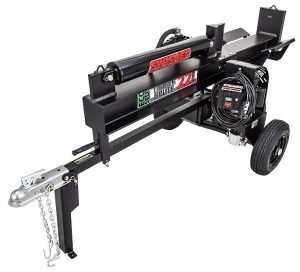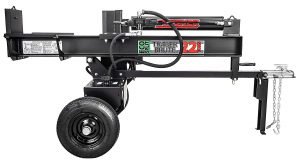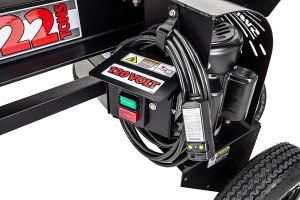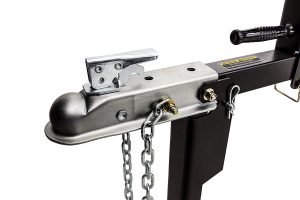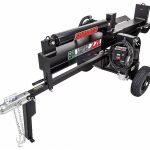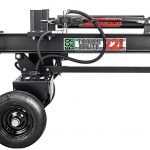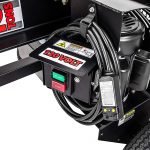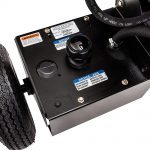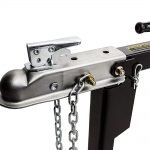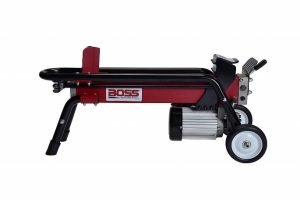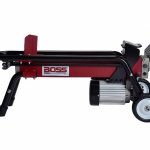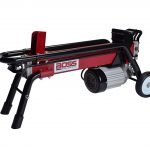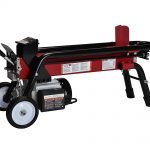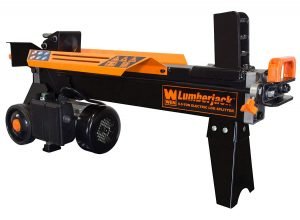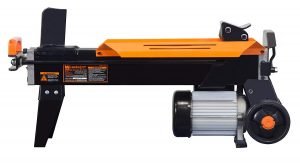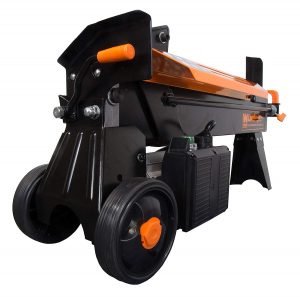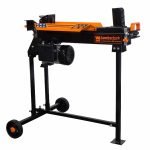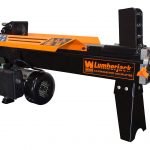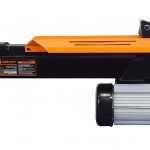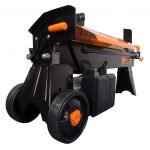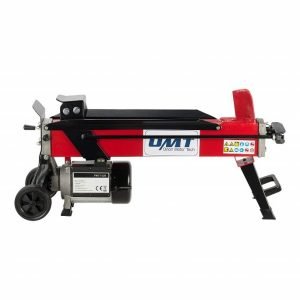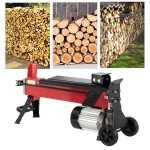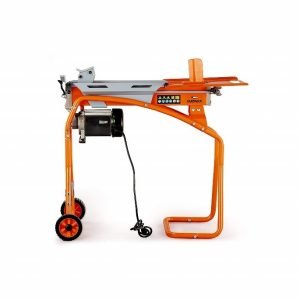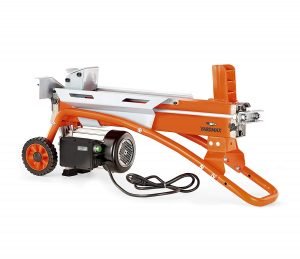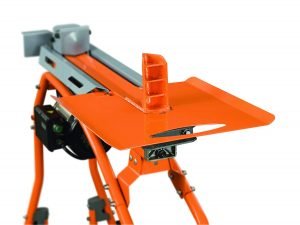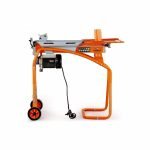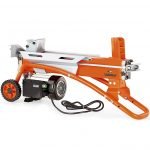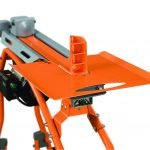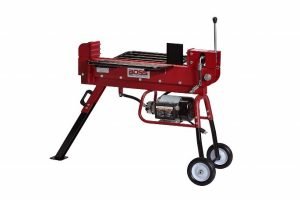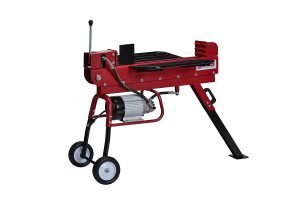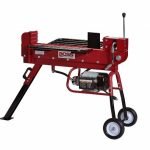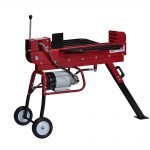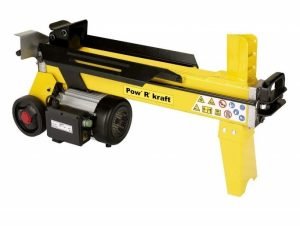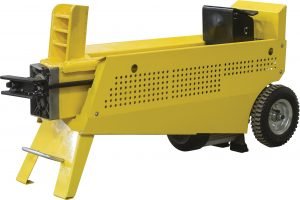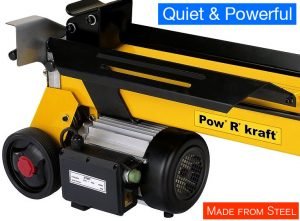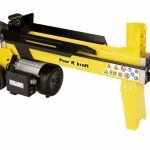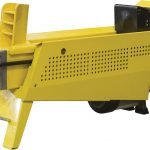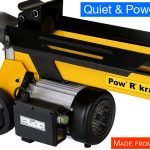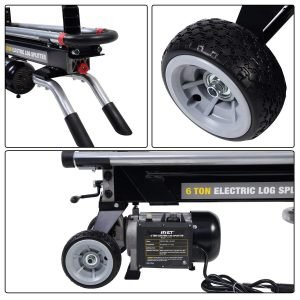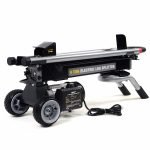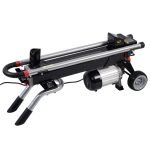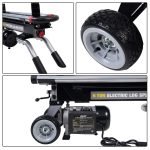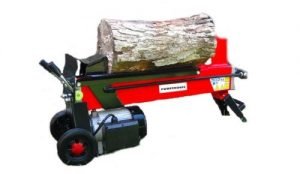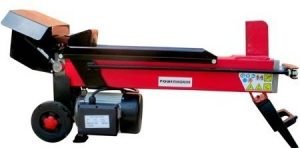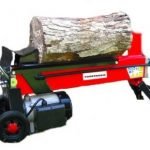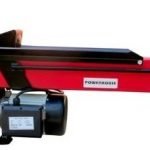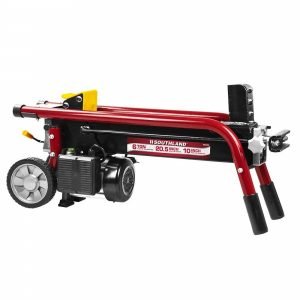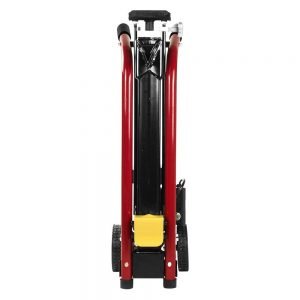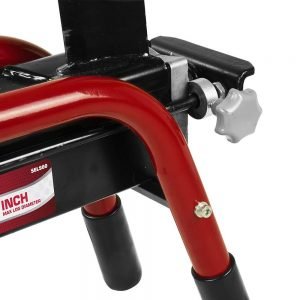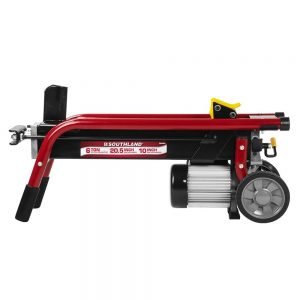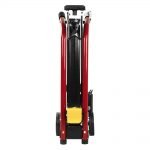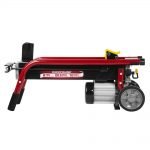If you have a pile of wood rounds in your backyard that need to be turned into usable firewood for the winter, there are few tools better to add to your arsenal than an electric log splitter. Electric log splitters let you split wood without the hassle, noise, and fumes of traditional gas-powered log splitters, as well as allow you to work inside your garage or shop when winter snow and rain is falling outside. Plus, electric log splitters offer enough power to allow you to split even the toughest, largest wood rounds quickly and easily.
In order to help you find the best electric log splitter for your needs, we considered a number of features that differentiate these tools. The first thing we looked at was splitting force, which indicates what types, diameters, and lengths of wood rounds you’ll be able to split with your splitter. We also looked at the engine and power, which affect the splitting force as well as durability, as well as whether the splitter is able to operate vertically so you can split logs that are too heavy to lift onto the splitter cradle.
We spent tens of hours researching the most popular electric log splitters, poring over customer reviews and technical specifications. The result is our picks of the top 10 electric log splitters, highlighted in the table below. Continue reading for detailed reviews of each splitter, complete with pros and cons. Our buying guide covers everything you need to know about choosing the electric splitter that is right for your needs. Finally, we sum up our three overall favorite electric log splitters on the market today.
-
Editor’s Choice: Swisher LS22E"This unique electric log splitter is on par with commercial gas-powered log splitters in terms of power, and operates in horizontal and vertical orientations."
-
Best Value: Boss Industrial ES7T20"This well-designed and durable log splitter features integrated rails keeping the log secure and was designed for one-handed operation for faster and more efficient splitting."
-
Most Adjustable Log Splitter: WEN 56207"This electric log splitter comes with several features that make it highly adjustable and easy to use, including a tall stand saving you a ton of bending over."
-
Fastest Electric Log Splitter: OrionMotorTech PM7T-520"This log splitter is incredibly fast, at just 10 seconds between logs, without compromising on power with its 3HP motor and 7 tons of splitting force."
-
Best for Logs of Up to 15 Inches: YARDMAX YS0552"This model is ideal for splitting softwoods up to 15 inches and also comes with a removable stand with large seven-inch wheels for ease of use and portability."
-
Most Durable Log Splitter: Boss Industrial ED10T20"Another model from Boss Industrial, this log splitter is more powerful than its little brother above, offering 10 tons of splitting force, and is also designed for one-handed use."
-
Best for Softwoods: Pow' R' Kraft 65556"This compact log splitter is designed for those who need a small splitter to handle medium-diameter softwood logs and then to easily store when not in use."
-
Best Compact Horizontal Model: Goplus 6T"This inexpensive log splitter is compact and easy to use and move about thanks to a handy wheel and handle system, and can be placed upright for storage."
-
Best for Large Diameter Logs: Powerhouse XM-380"This log splitter is best designed to split wider softwood or relatively narrow hardwood logs and can be configured for either one-handed or two-handed operation."
-
Budget Pick: Southland Outdoor Power Equipment SELS60"This affordable log splitter is a great choice for those who don’t need to split a ton of wood or who only have smaller logs and don’t need an industrial-quality splitter."
Top 10 Electric Log Splitters Review 2018
Swisher LS22E – Editor’s Choice
- Splitting type: horizontal and vertical
- Splitting force: 22 tons
- Motor: 2 HP
- Max log length: 25.5 in
- Max log diameter: not specified
- Cycle time: 13 sec
- Warranty: 1-year limited on hydraulic system, 3-year limited on materials and workmanship
It’s hard to compare this electric log splitter from Swisher to nearly any of the others we reviewed – according to both the technical specifications and user testimonies, it’s in a league of its own. For many users, this splitter is a direct replacement for a gasoline-powered splitter. It is the closest to commercial grade splitters you can get.
First of all, this is the only electric log splitter we reviewed that is capable of operating in both horizontal and vertical splitting orientations. This is in part because it is also the one of the few electric splitters with the splitting force to justify needing vertical splitting capabilities – smaller, easier to split logs you could simply load onto a horizontal splitter. This model features an impressive 22 tons of splitting force, putting it on par with many gasoline-powered log splitters and allowing it to handily deal with large-diameter hardwoods and greenwoods as well as softwoods. Users found that this splitter was significantly quieter than comparable gasoline-powered log splitters and could be used inside – a major advantage during the winter months.
The auxiliary design aspects of this splitter reflect the industrial specifications. The cradle is longer than nearly all other electric splitters at 25.5 inches so that you can easily deal with larger cuts of wood. The frame that the splitter is mounted on includes a trailer hitch so you can easily transport it between logging sites, as well as wheel it around with the included rubber wheels. The cycle time is also relatively fast, at 13 seconds, so that even when working in a team of two the splitter will be able to keep up the pace of work. Switching between horizontal and vertical orientations takes several minutes, but allows splitting huge logs that can otherwise not be lifted. The only complaint that users had was that some logs get stuck on the wedge after splitting and can be difficult to remove.
The splitter body is made of rust-resistant steel for extreme durability. Importantly, Swisher offers two separate warranties – a three-year warranty on the body and a one-year warranty on the all-important hydraulic system. However, users report that the splitter is extremely hardy in all respects over several years of use.
What makes it special?
- Extremely powerful with 22 tons of splitting force
- Operates in horizontal and vertical orientations
- Truck hitch on frame
- Three-year warranty on body
What cons did we find?
- Some logs get stuck on wedge
Boss Industrial ES7T20 – Best Value
- Splitting type: horizontal
- Splitting force: 7 tons
- Motor: 2 HP
- Max log length: 20.5 in
- Max log diameter: 10.5 in
- Cycle time: 9 sec (feed), 5 sec (retract)
- Warranty: 2-year limited
This electric log splitter from Boss Industrial is more expensive compared to some of the budget log splitters we reviewed, but users claim that the extra cost is well worth your investment. The splitter offers seven tons of splitting power thanks to the two-horsepower motor and users report splitting logs up to 17 inches around with it – even if it the log splitter is only rated to handle logs up to 10.5 inches. Users note that it also is capable of splitting medium-diameter hardwood logs by simply running the logs through the splitter twice, flipping them over after one impact with the splitter. Meanwhile, the horizontal cradle is long enough to accommodate 20.5-inch logs.
There are a few features that set the Boss Industrial electric splitter apart from competitors. First, Boss Industrial designed the cradle with integrated rails that are able to keep the log secure during impact, which reduces the likelihood of misfires and debris flying everywhere. At the same time, the rails don’t put a hard limit on the diameter of logs the cradle will fit. Users also appreciated that the splitter is designed for one-handed use, which allows you to get your work done faster and more efficiently. However, users warn that every now and then a piece of wood will explode upon impact without warning – so it’s important to stand behind the machine with your arm extended to the lever as you would when working with a two-handed log splitter. Users also commented positively on the size of this splitter, which is relatively small for its class – making it easier to store and move around the yard.
The cycle time on this splitter is nothing to write home about – a total of 14 seconds between impacts when running at full speed – but for most users working alone the cycle time is also short enough not to slow them down by much. The auto-retraction of the ram works well and almost never sticks after impacting a piece of wood.
Boss Industrial provides a two-year warranty on their electric log splitter, although almost no users report experiencing issues that required calling in the warranty.
Why did it make our list?
- Able to split logs 17 inches or more
- Integrated rails hold logs in place
- One-handed operation
- Well-designed and durable
What is not ideal about it?
- Cycle time is somewhat long
WEN 56207 – Most Adjustable Log Splitter
- Splitting type: horizontal
- Splitting force: 6.5 tons
- Motor: 15A
- Max log length: 20.5 in
- Max log diameter: 10 in
- Cycle time: 20 sec
- Warranty: 2-year limited
This electric log splitter from Wen is perfect for those who want to dial in all of the specifications of their log splitting to achieve the highest levels of efficiency. The first, most noticeable thing about this log splitter that sets it apart from others is that it comes on a 34-inch tall stand – one of only a few log splitters we reviewed that comes with such an accessory. The splitter can be used with or without the stand according to your preferences, although nearly all users opted to use it since it is quite stable and saves a ton of bending over when operating the splitter. In addition, the splitter is designed with support wings – essentially guide rails – around the cradle to prevent wood from slipping out during the ramming process.
The ram itself is also adjustable in terms of how far it extends down the shaft of the splitter, which users loved since it can drastically reduce the length of the cycle time and increase efficiency. When travelling the full distance of the cradle, note that this splitter has an extremely slow cycle time of 20 seconds – so adjusting the travel distance can have a significant impact on your workflow.
As for the power of this electric log splitter, users were quite satisfied. The splitter is built around a 15-amp motor that delivers 6.5 tons of splitting force – enough to easily handle any logs up to the 10-inch diameter that the splitter is rated for. However, unlike splitters with a slightly beefier two-horsepower motor, you can expect this splitter to be true to its rating – users report having trouble when trying to split larger logs or wet greenwood logs.
This splitter is relatively portable thanks to the hard plastic 5.5-inch wheels mounted under the frame. The wheels can also be attached to the base of the support stand so that the splitter is portable even in this configuration.
Wen offers a two-year warranty on this electric log splitter, although almost no users reported issues with the splitter after a few years’ of use.
Why is it special?
- Comes with support stand accessory
- Ram travel distance is adjustable
- Portable
- Two-year warranty
- Comes with support stand accessory
- Ram travel distance is adjustable
- Portable
- Two-year warranty
What are the flaws?
- 20-inch cycle time at full travel distance
- Limited to 10-inch diameter logs
OrionMotorTech PM7T-520 – Fastest Electric Log Splitter
- Splitting type: horizontal
- Splitting force: 7 tons
- Motor: 3 HP
- Max log length: 20.5 in
- Max log diameter: 12 in
- Cycle time: 10 sec
- Warranty: 2-year warranty
There are a number of excellent design features to point to in this electric log splitter from OrionMotorTech, but what really sets it apart from the competition is the blazingly fast cycle time. At just 10 seconds between logs, even with a partner you’ll likely be struggling to keep up with this splitter. And while you might not need quite that much speed, users note that just knowing the splitter won’t slow you down can actually increase your splitting efficiency over the course of a day.
This splitter also doesn’t compromise on power. It features a three-horsepower motor – one of the larger motors on electric log splitters in this price and size class – and provides seven tons of splitting force. The result is that this splitter is rated to deal with 12-inch diameter logs – a major jump above what most of the other splitters we reviewed can handle. Although the splitter can likely handle even larger wood rounds, it does not come with the guide rails found on other splitters so keeping these large logs from squirming around the cradle when pressured may be an issue. The splitter is the same overall length as most competitors, leaving enough room for logs up to 20.5 inches in length.
One of the few things that users did not love about this splitter is that it requires two-handed operation. A safety button must be depressed at the same time the control lever is held down, meaning that you’ll need both hands on the splitter over the course of the 10-second cycle time. While all users can agree that this is a good safety feature, be forewarned that you won’t be able to hold a mug of coffee while splitting wood or work ahead with a free hand.
OrionMotorTech offers a two-year warranty on this log splitter, which some users report calling in because of damage during shipping. However, manufacturing issues with the splitter itself seem to be rare and the steel body and cast-iron splitting wedge are designed for long-term durability.
What are our favorite features?
- 10-second cycle time
- Three-horsepower motor splits 12-inch diameter logs
- Two-year warranty
What could be better?
- Two-handed operation reduces efficiency
- No guide rails around cradle
YARDMAX YS0552 – Best for Logs of Up to 15 Inches
- Splitting type: horizontal
- Splitting force: 5 tons
- Motor: 15A
- Max log length: 20.5 in
- Max log diameter: 10 in
- Cycle time: 16 sec
- Warranty: 2-year
Users loved this handy splitter from Yardmax, which features a number of design features that make it easier to use. It is worth noting off the bat this this splitter is only rated for five tons of splitting force – significantly less than some competitors – despite the burly 15-amp motor. However, it is still rated to split logs up to 10 inches in diameter and users report being able to split softwoods up to 15 inches with this splitter without an issue.
The cradle of this splitter is 20.5 inches long like most of the other splitters we reviewed, corresponding to a moderate 16-second cycle time for the ram head. However, Yardmax designed the ram with a stroke limiter, which users loved for cutting down the cycle time by a few seconds or more when working with shorter logs.
To improve safety, Yardmax designed this splitter to require two-handed operation. While your feelings about this feature will depend on your own preferences, many users are slightly annoyed by the safety requirement.
One of the major advantages to this electric log splitter is that, like the model from Wen, it comes with a stand to reduce the amount of bending over you need to do when splitting logs. The stand is removable, although putting it on and taking it off does require a few minutes of hardware assembly. The large seven-inch wheels also can be moved between the base of the splitter and the base of the stand so that it remains portable in either configuration. It is also worth noting that this splitter has a log catcher so that split logs will remain around the cradle, at a good working height on the stand, rather than fall to the floor after being split.
Yardmax offers a two-year warranty on this splitter, although users report that their models of this splitter continue to work well after several years of use and the fully steel construction appears to be as durable as intended.
What makes it special?
- Splits softwoods up to 15 inches
- Included stroke limiter to reduce cycle time
- Removable stand
- Two-year warranty
What cons did we find?
- Only rated for 10-inch diameter logs
- Two-handed operation required
Boss Industrial ED10T20 – Most Durable Log Splitter
- Splitting type: horizontal
- Splitting force: 10 tons
- Motor: 1.5 HP
- Max log length: 20.5 in
- Max log diameter: 12 in
- Cycle time: 16 sec (feed), 13 sec (retract)
- Warranty: 2-year limited
If you want the burliness of a gasoline-powered log splitter but none of the downsides that come from running a gasoline engine, look closely at this powerful electric log splitter from Boss Industrial. Although it is costly compared to many of the similarly sized electric log splitters we reviewed, that cost is justified according to users by the durability and power of this splitter. The engine is nominally only 1.5-horsepower, but runs on a 20-amp outlet – and is powerful enough to dim your shop’s lights if you accidentally plug it into a standard 15-amp outlet! With all that engine power, this splitter is able to put out a whopping 10 tons of splitting force – allowing to be rated for 12-inch diameter logs and for users to find that it easily splits softwoods up to 16 inches or beyond. The hydraulic system on this splitter is extremely durable and automatically shuts down if it is overpressured to protect the seals, so you don’t need to worry if you try loading logs that are a little bit too ambitious.
The trade-off to all of this power is that the cycle time on this splitter is extremely slow – nearly 30 seconds roundtrip. Even when working alone, this is slow enough to put a cap on how fast you can work, which may be an issue if you have a huge number of logs to split. There is also no stroke limiter that would allow you to increase the cycle time. Despite this, users appreciated that the splitter is designed for one-handed operation so you can actually use one hand to do other things during that 30 second wait.
It is also worth noting that this splitter is extremely heavy compared to similarly sized electric log splitters. Users report having difficult completing the assembly and even replacing the hydraulic fluid by themselves because of the weight. The poor instruction manual, which does not specify the amount of hydraulic fluid needed by the splitter, also does not help matters.
However, users still love this splitter for its extreme durability – Boss Industrial warranties it for two years, but users note that it runs as if it were new after several years of use.
Why is it special?
- Burly engine with 10 tons of splitting force
- One-handed operation
- Automatic shutoff when overpressured
- Two-year warranty
What are the flaws?
- Expensive
- Heavy
- Poor user manual
- Long 30-second cycle time
Pow' R' Kraft 65556 – Best for Softwoods
- Splitting type: horizontal
- Splitting force: 4 tons
- Motor: 15A
- Max log length: 20 in
- Max log diameter: 10 in
- Cycle time: 6 sec (feed), 5 sec (retract)
- Warranty: 2-year limited
This compact splitter from Pow’R’Kraft is perfect for those who need a small splitter that they can easily store in the garage when not in use. This splitter is built around a pared-down 15-amp motor that delivers just four tons of splitting force – so plan to feed primarily medium-diameter softwood logs to this splitter and to avoid hardwoods entirely. The maximum log length is 20 inches, which is worth noting only in that it is half an inch shorter than nearly all other electric log splitters on the market. Despite the smaller size, users who opted for this splitter were extremely pleased with its performance and many were glad to have avoided getting an unnecessarily large and powerful splitter.
The advantage of this small log splitter is that it boasts a speedy 11-second cycle time, which allows you to rapidly split a cord of wood whether working on your own or in a team of two. Although there is no stroke limiter built into the splitter, some users were able to rig a homemade limiter out of vice grips to further increase the cycle time when working with short logs. Users also liked the slight guide rails around the cradle that helped to keep wood in place as the ram was pressuring it. The splitter is designed for two-handed operation, which many users were not as pleased with, but some users were able to find simple workarounds for this as well.
The hard plastic wheels on this splitter make it easy to transport through your yard, and users loved that they could stand the splitter on its end for storage when not in use.
Users found that the simple, fully steel design of this splitter is extremely durable, essentially rendering Pow’R’Kraft’s two-year warranty unnecessary. It is worth noting that this splitter model has been discontinued, but remains easily available and the company continues to honor their warranty on the splitter.
Why is it special?
- Small, compact splitter
- 11-second cycle time
- Steel design is extremely durable
- Two-year warranty
What are the flaws?
- Only four tons of splitting force
- Two-handed operation
- No stroke limiter for short logs
Goplus 6T – Best Compact Horizontal Model
- Splitting type: horizontal
- Splitting force: 6 tons
- Motor: 2 HP
- Max log length: 20.4 in
- Max log diameter: 9.8 in
- Cycle time: not specified
- Warranty: 1-year limited
This inexpensive log splitter from Goplus is a compact and easy to use choice for homeowners who need to get through a pile of wood in short order. The splitter features one of the best wheel and handle systems we’ve seen, making it easy to transport the splitter around your garage or across your yard to where you need it (assuming you have a long enough extension cord to pair with it). An added bonus is that it’s easy to stand the splitter upright for storage when not in use so that it takes up less space in your garage.
The power of this two-horsepower splitter is somewhat limited at only six tons and it is rated for only 10-inch logs. However, users were quite happy with its performance on both softwoods and hardwoods, noting that the 10-inch diameter rating is quite accurate. Users found that the cycle time is fast enough that the splitter won’t slow down your work, but warned that you won’t want to split a whole cord of wood without a break as the splitter can start to get hot over time. They also appreciated the low-profile guide rails on either side of the cradle that act to keep logs in place as they are being split.
One of the main things that users wished for with this splitter was a stand – the wheelbase design makes it difficult to mount even on a table, and bending over repeatedly to split logs can get exhausting at the end of a long day. In addition, users disliked the fact that this splitter incorporates two-handed operation for safety.
Goplus offers a one-year warranty on this splitter that must be activated by mailing in a registration card upon purchase. Users found that the splitter is durable enough for several years’ of use, but will start to show signs of wear and tear after a couple cords of wood.
What do we love it for?
- Inexpensive
- Works well on 10-inch softwoods and hardwoods
- Excellent wheel and handle design
- Durable
What were we disappointed with?
- Starts to overheat over time
- Not easy to put it on a stand
- Two-handed operation
Powerhouse XM-380 – Best for Large Diameter Logs
- Splitting type: horizontal
- Splitting force: 7 tons
- Motor: 3 HP
- Max log length: 20.5 in
- Max log diameter: 12 in
- Cycle time: 6 sec (feed), 5 sec (retract)
- Warranty: 1-year limited
This compact and durable electric log splitter from Powerhouse is a great choice for users who need to get through a large pile of wood relatively quickly. The splitter is built around a three-horsepower, 15-amp motor that produces seven tons of splitting force. Users found that the rated 12-inch maximum log diameter is roughly accurate for this splitter, and that even at this diameter the splitter can struggle with knotted hardwoods – meaning this splitter is best suited for splitting softwood logs and only relatively narrow hardwood logs. The splitter turns off automatically when overpressured in order to protect the seals and prevent hydraulic fluid from leaking.
Users found that the splitting action on this splitter worked relatively well for most logs, but was sub-optimal when loading logs that take up the entire 20.5-inch length of the cradle. This is because the ram travels only 15.7 inches of the cradle and the wedge is relatively narrow, leaving partially split logs that then have to be finished by hand. Users also wished for a stand for this splitter, since working through this manual splitting at ground level can wear on your back. That said, the 11-second cycle time on this splitter is a major advantage for those who need to split a large pile of medium-sized logs in a short amount of time, especially if you are working in a team of two. Another advantage that users appreciated is that the splitter can be configured for either one-handed or two-handed operation depending on your preference.
Another minor flaw to consider in this splitter that users noted is that the wheels are relatively close together, which allows the splitter to tip over when you are transporting it across uneven ground in your yard.
With those caveats in mind, users found this splitter to be well-constructed and extremely durable. Powerhouse offers a one-year warranty in case of any manufacturing issues, but very few users needed to activate this warranty.
What makes it special?
- Rated for 12-inch diameter logs
- 11-second cycle time
- One-handed or two-handed operation
What cons did we find?
- Ram does not travel full length and wedge is somewhat narrow
- Wheels are too close together
- Only one-year warranty
Southland Outdoor Power Equipment SELS60 – Budget Pick
- Splitting type: horizontal
- Splitting force: 6 tons
- Motor: 1.75 HP
- Max log length: 20.5 in
- Max log diameter: 10 in
- Cycle time: 18 sec
- Warranty: 1-year
This low-priced electric log splitter from Southland Outdoor Power Equipment is a great choice for those who don’t need to split a ton of wood or who only have smaller logs, and therefore don’t want to spend tons of money on a more industrial-quality splitter.
That’s not to say this splitter doesn’t pack a punch – the 1.75-horsepower, 15-amp motor provides six tons of splitting force and the splitter is rated to deal with logs up to 10 inches in diameter. Some users report being successful splitting even larger rounds with this splitter, and it doesn’t hurt to try thanks to the automatic shutoff feature. This means that when the splitter is working above its available power, it will shut down rather than potentially damage the seals and cause a hydraulic fluid leak.
Like many other electric log splitters in its class, the cradle on this splitter is long enough to hold logs up to 20.5 inches. The splitter is also designed for convenient portability and storage, with burly seven-inch wheels under the frame and the ability to stand it vertically in your garage (although it cannot be operated in the vertical orientation).
The biggest downside to this electric log splitter is the cycle time – at 18 seconds, the wait between activations will be noticeable, especially if you’re working in a team of two people. In fact, this is one of the main reasons we recommend this splitter primarily for home users who aren’t splitting wood all of the time. With that caveat in mind, the cycle time won’t slow down your work too extremely and users appreciate the reliability of the auto retraction on this splitter.
It’s also worth noting that while the vast majority of users have had good experiences with this splitter, a few have complained of manufacturing defects including a ram that fails to retract properly and poor seals that leak hydraulic fluid after only a few uses. Southland Outdoor Power Equipment only offers a short one-year warranty, so for users who are powering up their log splitter only infrequently it may be hard to detect these issues within the warranty period.
What stands out?
- Inexpensive
- Automatic shutdown when overpowered
- Can be stored vertically
What cons did we manage to find?
- Short one-year warranty
- Occasional manufacturing issues
- Slow 18-second cycle time
Things to Consider
Now that you’ve read more about our 10 favorite electric log splitters on the market today, how do you choose between them to get the splitter that is best for the type of wood rounds you plan to split? There are a number of factors to take into account when choosing an electric log splitter – everything from whether an electric splitter is really the best choice of splitter for your needs to whether the splitter you choose will have enough power to split the type and size of wood rounds you have to how easy it is to maintain your chosen splitter. In our Buying Guide, we’ll cover the advantages and disadvantages of electric log splitters, highlight the features you need to know about when choosing a splitter, and offer some tips about how to use and maintain your electric log splitter so that it is both safe and effective.
Electrical log splitters: advantages and disadvantages
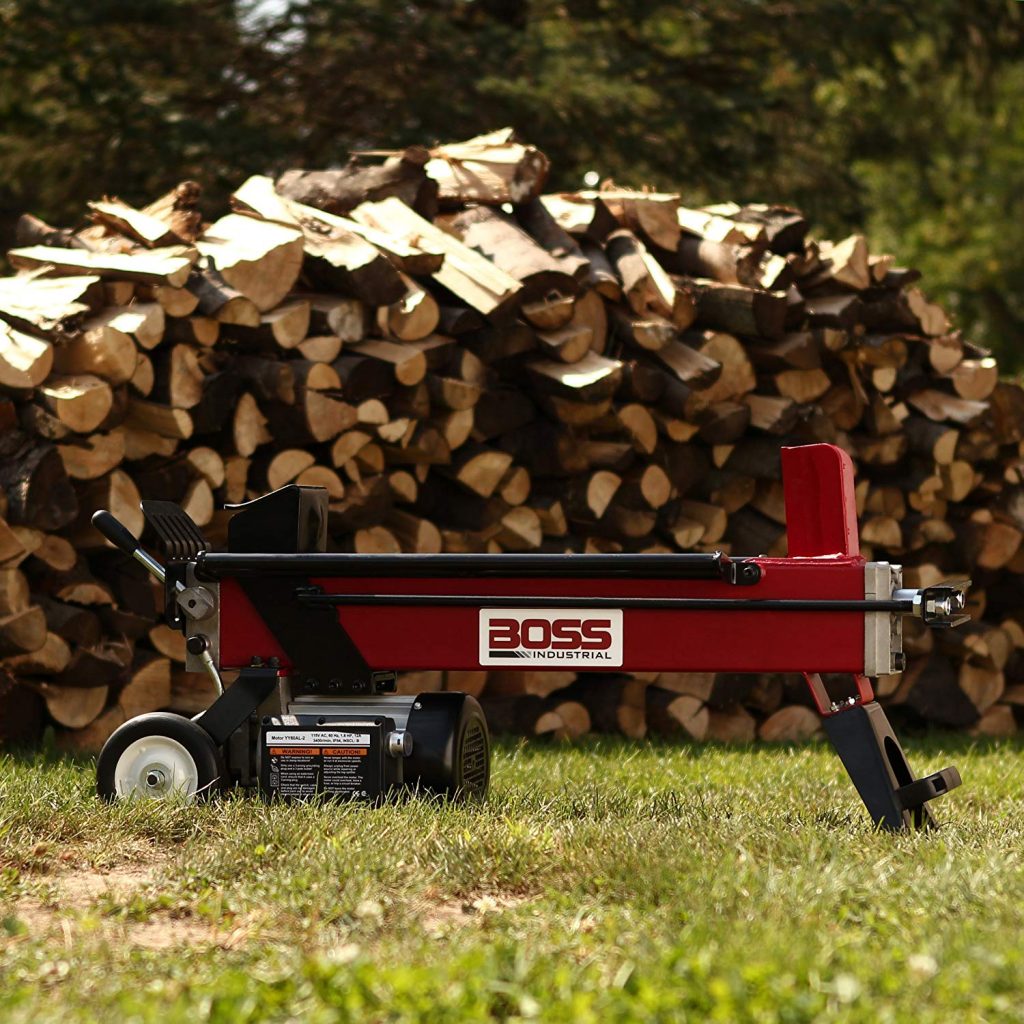 Is an electric log splitter truly a better choice for you than a traditional gasoline-powered or manual log splitter? To answer that question, you first need to understand the unique advantages and disadvantages of electric log splitters compared to these other designs.
Is an electric log splitter truly a better choice for you than a traditional gasoline-powered or manual log splitter? To answer that question, you first need to understand the unique advantages and disadvantages of electric log splitters compared to these other designs.
There are a number of advantages to electric log splitters over both gasoline-powered and manual splitters. First, compared to manual splitters, electric log splitters require only a fraction of the effort and time because the electric motor provides the force needed to split a wood round – rather than requiring you to pump a hydraulic jack or repeatedly hammer at a piece of wood.
Compared to gasoline-powered splitters, electric splitters are significantly quieter when running, which saves your ears over time and can be important if your yard backs up against neighbor’s houses and the sound of splitting wood will bother them. Electric splitters also produce none of the same gasoline fumes or carbon monoxide, which means that you can take your splitting operation into your garage or shop and out of the freezing winter snow and rain without worrying about suffocation hazards.
On top of all of that, electric log splitters are typically cheaper to operate – since gasoline is expensive – and don’t require that you keep a tank of fresh gasoline around your garage.
That said, there are some important disadvantages of electric log splitters compared to gasoline-powered splitters. The foremost is splitting power – while the best electric log splitters can compete with medium-sized gasoline-powered splitters, large gasoline-powered splitters can far exceed the splitting force capacity of any electric log splitter. Although this can make a difference when you are working with huge wood rounds, like those from old-growth hardwood trees, most home users will have no issues with the power output of electric log splitters. Another disadvantage is the durability of electric motors. In general, electric motors do not last as long as well-cared for gasoline engines and are harder to fix cheaply when something breaks.
Finally, one of the main disadvantages that home users are likely to notice is that electric log splitters are limited in their range of use by a power cord. This means that it will be difficult or impossible to bring your splitter out into the woods without a generator – at which point you might as well use a gasoline-powered splitter. So, plan on bringing your wood close to the house when using an electric log splitter.
Features to consider while choosing an electric log splitter
There are a huge number of factors that affect how your electric log splitter will perform at splitting the wood you have around your yard. In this section, we’ll cover some of the most important features you need to know about when choosing an electric log splitter and explain how they will affect how you can use your splitter.
Horizontal, vertical, or combo splitters
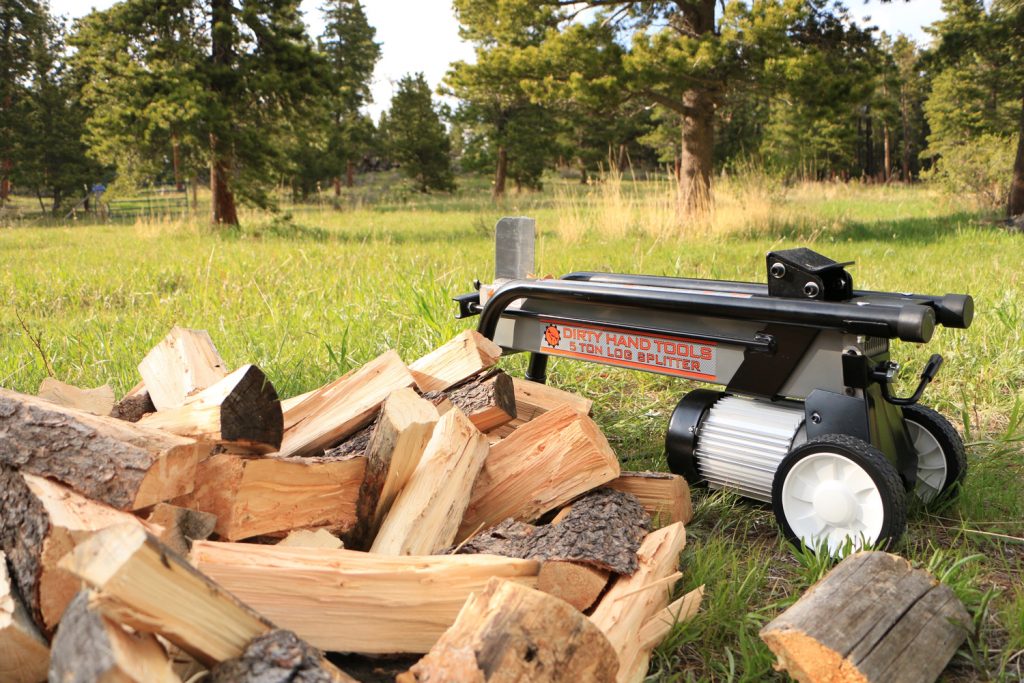 The vast majority of electric log splitters are horizontal splitters, meaning that the cradle is oriented parallel to the ground. These splitters require that you lift the wood round you want to split from the ground onto the cradle, rather than bring the splitter to your wood. Although this is fine for most logs, it can be quite difficult to lift large and heavy logs – which is where a vertical log splitter like the model from Goplus comes in handy. Vertical splitters are designed to split a log that is sitting on the ground, so that you don’t have to lift the log itself.
The vast majority of electric log splitters are horizontal splitters, meaning that the cradle is oriented parallel to the ground. These splitters require that you lift the wood round you want to split from the ground onto the cradle, rather than bring the splitter to your wood. Although this is fine for most logs, it can be quite difficult to lift large and heavy logs – which is where a vertical log splitter like the model from Goplus comes in handy. Vertical splitters are designed to split a log that is sitting on the ground, so that you don’t have to lift the log itself.
Splitting force
The splitting force is one of the most important technical specifications of any electric log splitter because it describes the amount of power that the splitter can exert on a wood round – which in turn determines what diameter and length of softwoods and hardwoods you’ll be able to split with your splitter. Splitting force is typically measured in tons and ranges from the four to six tons found on most of the splitters we reviewed to as much as 22 tons on the Swisher splitter.
As a rule of thumb, six tons of splitting force is enough to split a six-inch diameter softwood log, while it takes 12–15 tons to split a 12-inch diameter log of the same wood. When dealing with hardwoods, you will need a splitter with more splitting force – a six-inch diameter hardwood log requires around 10 tons of force to split, while a 12-inch diameter log of the same wood will require as much as 22 tons of force.
Engine and power
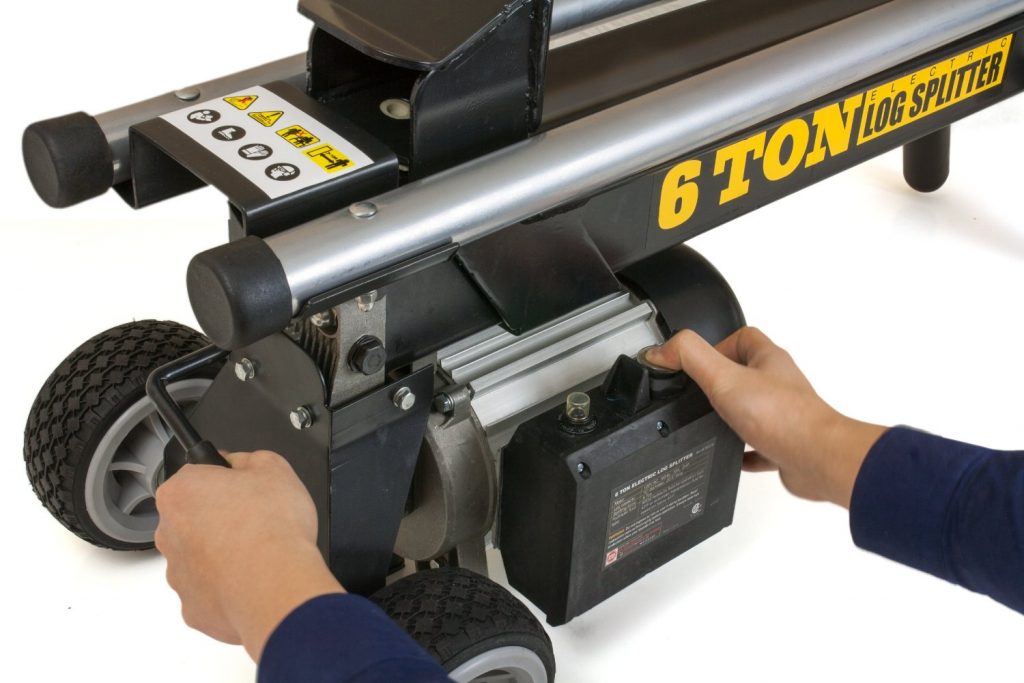 The engine that drives each electric log splitter is also important to consider when choosing a splitter. The power output from electric engines somewhat translates to the splitting force, although not directly – for example, both the Swisher and OrionMotorTech splitters are equipped with two-horsepower engines, but the OrionMotorTech has a splitting force of only seven tons while the Swisher splitter boasts 22 tons of force. Thus, a larger engine is not always necessary and will draw more electrical power, thus increasing the operating cost of your splitter. Smaller 15-amp motors are also extremely common among electric log splitters – for example, these motors are found on the Pow’R’Kraft, Yardmax, and Wen splitters.
The engine that drives each electric log splitter is also important to consider when choosing a splitter. The power output from electric engines somewhat translates to the splitting force, although not directly – for example, both the Swisher and OrionMotorTech splitters are equipped with two-horsepower engines, but the OrionMotorTech has a splitting force of only seven tons while the Swisher splitter boasts 22 tons of force. Thus, a larger engine is not always necessary and will draw more electrical power, thus increasing the operating cost of your splitter. Smaller 15-amp motors are also extremely common among electric log splitters – for example, these motors are found on the Pow’R’Kraft, Yardmax, and Wen splitters.
Log length and diameter
The length and diameter of the logs that you can split will depend in part on the splitting force of your splitter, but also on the design of the cradle or vertical splitting system. This is because the cradles of electric log splitters can only accommodate logs up to a certain size.
The length of log depends more on the overall size of the splitter – most of the splitters we reviewed are designed to hold logs up to 20 inches long, although the Swisher splitter can accommodate logs as long as 25 inches. Logs longer than these maximum lengths will need to be cut down to size with an axe or chainsaw before splitting.
Cycle time
The cycle time of an electric log splitter describes the amount of time the splitter requires to reset between splitting logs. Splitting times range from as brief as 10 seconds on the OrionMotorTech splitter to as long as 30 seconds on the Boss Industrial splitter. Note that some splitters measure both the feed and retraction cycle times, which need to be added together to calculate the full cycle time.
While a faster cycle time may seem desirable, this is only necessary up to a point. Most single users will not be able to realistically remove a split log and load a new log in less than 15–20 seconds, and even for a pair of users it is difficult to unload, load, and activate a log splitter while paying attention to good safety practices in less than 12 seconds. Therefore, splitters with cycle times less than 12–15 seconds all offer roughly the same level of fast performance.
Single-handed or two-handed operation
While it strictly only takes one hand to operate an electric log splitter – typically pulling a ram lever to activate the splitting action – many splitters require two hands to operate as a safety function. In the case of a two-handed electric splitter, the second hand has to hold down another lever or button while the lever is activated in order for the splitter to work. This design makes sure that both of your hands are away from any dangerous areas of the splitter while it is operating, but some users do not like this design because they want to use their second hand for other things while splitting.
Warranty
An electric log splitter is a major investment in your arsenal of yard tools, so you want to be sure that it will function efficiently for many years to come. Having a warranty on an electric log splitter is especially important since electric motors are difficult and costly to repair, in contrast to gasoline-powered motors. Warranties on electric log splitters are typically short – one to two years – although some manufacturers like Swisher offer separate warranties on the hydraulic system and the rest of the splitter so that the body of the splitter can be covered for a longer period.
How to use a log splitter?
 Using a log splitter is relatively straightforward. To start, make sure you have your log rounds properly cut to size and are certain that your splitter offers enough splitting force to split the type and diameter of logs you are loading. It is also good practice to cut the ends of the log flat so that there are no irregular edges.
Using a log splitter is relatively straightforward. To start, make sure you have your log rounds properly cut to size and are certain that your splitter offers enough splitting force to split the type and diameter of logs you are loading. It is also good practice to cut the ends of the log flat so that there are no irregular edges.
For horizontal splitters, simply load the log onto the cradle with one end of the log flat against the endplate. When ready, activate the splitter by pulling on the ram lever – you may also need to hold a safety button or lever if your splitter requires two-handed operation. Allow the splitter to retract before removing any splintered pieces of wood from the cradle, and be sure to pick up the split logs from around the splitter so that you do not trip when loading the next wood round into the cradle.
Maintenance tips
When do you know that it’s time to change the hydraulic fluid? Best practice is to check the splitter’s dipstick before each session of use – the dipstick should be marked with lines to indicate the minimum and maximum hydraulic fluid levels.
If you forget to change the fluid and end up with a humming electrical motor that won’t trigger the ram when you pull the lever, that is a sure sign that it’s time to change the hydraulic fluid.
More general maintenance includes cleaning the splitter of wood chips and dust to keep everything running smoothly and ensuring that all bolts are tightened properly before each new season. It is also a good idea to check the electrical cord for fraying, since this is a common breakage point that can lead to a dangerous electrical hazard.
Extension cords
If you’re operating a splitter in your yard, you’ll almost certainly need an extension cord – otherwise you’ll be tethered to within a few feet of the AC outlet on your house’s wall. Pay close attention when choosing an extension cord for your splitter, since not all of these cords are made the same. Specifically, it is essential that you use a 12-gauge extension cord for an electric log splitter. While a lower-gauge cord will also work if you already have one sitting in your garage, the added expense of these thicker extension cords is not otherwise necessary. Note that a 14- or 16-gauge is not sufficient for operating an electric log splitter.
The reason that a 12-gauge or thicker extension cord is required is that electric log splitters require a lot of current (15 amps or more) to run at their maximum power – and thus require a lot of wiring to deliver that electricity. Using a thinner extension cord will cause your log splitter to run at less than its optimal power output and will increase the heat put out by the wires, which can ultimately damage your splitter’s motor and decrease the lifespan of your tool.
Safety considerations
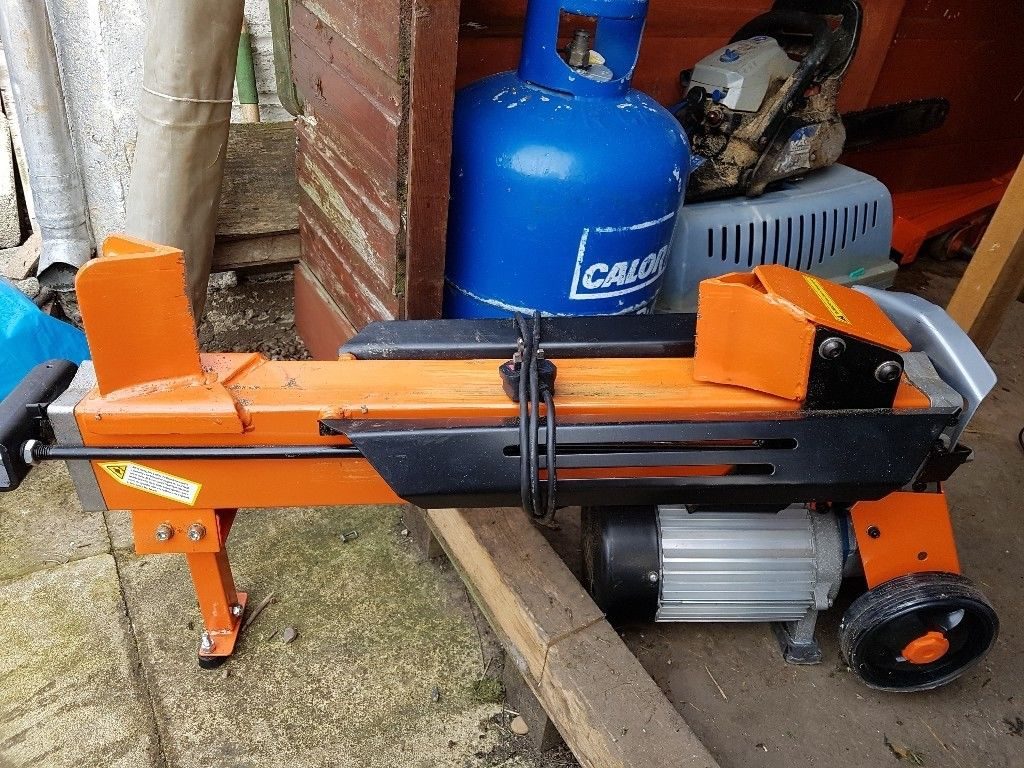 Whenever using an electric log splitter, safety is paramount – the massive, rapidly moving ram on a log splitter can be quite dangerous if any part of your body gets in its way, while the splitting wood can present a hazard in and of itself.
Whenever using an electric log splitter, safety is paramount – the massive, rapidly moving ram on a log splitter can be quite dangerous if any part of your body gets in its way, while the splitting wood can present a hazard in and of itself.
The first step in protecting yourself when operating an electric log splitter is to wear proper safety clothing. You should always wear eye protection, since splitting wood can fly in any direction – including towards your eyes. A hard hat, thick workman’s apron, and thick pants are good ideas for the same reason. Always wear close-toed shoes, since it is easy to drop a log on your foot when loading or unloading the splitter. Finally, be sure to wear gloves when handling wood, since split logs typically have many splinters that can lodge themselves in your skin otherwise.
Operating the splitter itself also requires attention to safety. When working in teams of two or more, best practice is that whoever loads a log onto the splitter is the same person to active the splitter to split that log – this ensures that the second person in a team does not activate the splitter before the first person has fully cleared the cradle. Opting for an electric log splitter that requires two-handed operation to activate the ram is also a good idea to increase safety, since this ensures that both of your hands must be clear of the cradle before the ram can be triggered.
Finally, consider the logs you are planning to split. Make sure that they are within the capacity of the splitter you have – both in terms of their length and diameter as well as the force required to split them. It is good practice to cut the ends of the log flat so that the ram and endplate will not encounter irregular surfaces that allow the log to slip when it is impacted.
FAQ
It is very important that you choose an extension cord that is rated as 12-gauge or lower (thicker) when extending the power cord of your electric log splitter. 14- and 16-gauge power cords, which you are more likely to already have in your garage and are less expensive, do not provide enough wire area for the power draw required by the large electric motors found in electric log splitters. These thinner extension cords will lead to overheating and suboptimal power being delivered to your splitter, which can damage the motor over time and reduce the lifespan of your electric log splitter.
How you move your log splitter depends on how you model of electric log splitter is designed. Nearly all electric log splitters, including all of those we reviewed, are mounted on a pair of wheels that allows you to wheel them around the yard. If you need to move your log splitter over longer distances, it is worth choosing a log splitter that comes mounted with a truck hitch, such as the splitter from Swisher, although most electric log splitters are also small enough to be loaded into the bed of a pickup truck.
While electric log splitters can split nearly any type of wood, it is worth noting that softwoods and hardwoods require vastly different amounts of splitting force to break through. As a result, the types of wood that you can realistically split will depend on the splitting force of your particular splitter. Most electric log splitters only provide enough splitting force to split softwoods, although burlier splitters like the model from Swisher are capable of splitting hardwoods up to 12 inches in diameter. You can split hardwoods with a less powerful electric log splitter, although this may require first cutting your logs down to half-rounds six inches or less in diameter.
Electric log splitters do not require motor oil like gasoline-powered log splitters, but they do require hydraulic fluid to continue to run smoothly. In general, most electric log splitters use 10W oil since this is designed to work smoothly either in high temperatures – like those generated inside your splitter when it has been running for some time – or in cold temperatures – like those your splitter will experience when just starting to use it in the middle of cold winter weather.
How frequently you need to change the hydraulic oil in your electric log splitter depends most on how frequently you use the splitter. For infrequent users, it is likely enough to change the hydraulic oil once every several years. However, consistent users and commercial users will need to change the hydraulic oil once per year or even more frequently. In general, it is good practice to check the dipstick at the beginning of each use or each season to see whether your hydraulic fluid is getting low – this will prevent you from running into an issue with the splitter triggering, which is a sure and late sign that you have run too low on hydraulic oil.
Our Verdict
Our three overall favorite electric log splitters on the market today are the Swisher LS22E, the Boss Industrial ES7T20, and the Wen 56207. The Wen splitter stood out for its inclusion of a removable stand that drastically reduces the amount of backbreaking bending involved in splitting wood, as well as the adjustability afforded by the stroke limiter. We like the Boss Industrial splitter as a heavy-duty electric log splitter for home users with large-diameter and hardwood rounds thanks to its seven-ton splitting force. Users found that this splitter is capable of splitting logs up to 17 inches around and, paired with the 14-second cycle time, can make quick work of a cord of wood. We feel the Swisher splitter is in a league of its own and is the overall best electric log splitter available today thanks to its incredible 22 tons of splitting force and ability to operate both horizontally and vertically. For many users, this splitter directly competes with gasoline-powered splitters on power and has none of the drawbacks of gasoline.
The post 10 Best Electric Log Splitters to Help You Out with Firewood appeared first on HouseAndBeyond.org.
